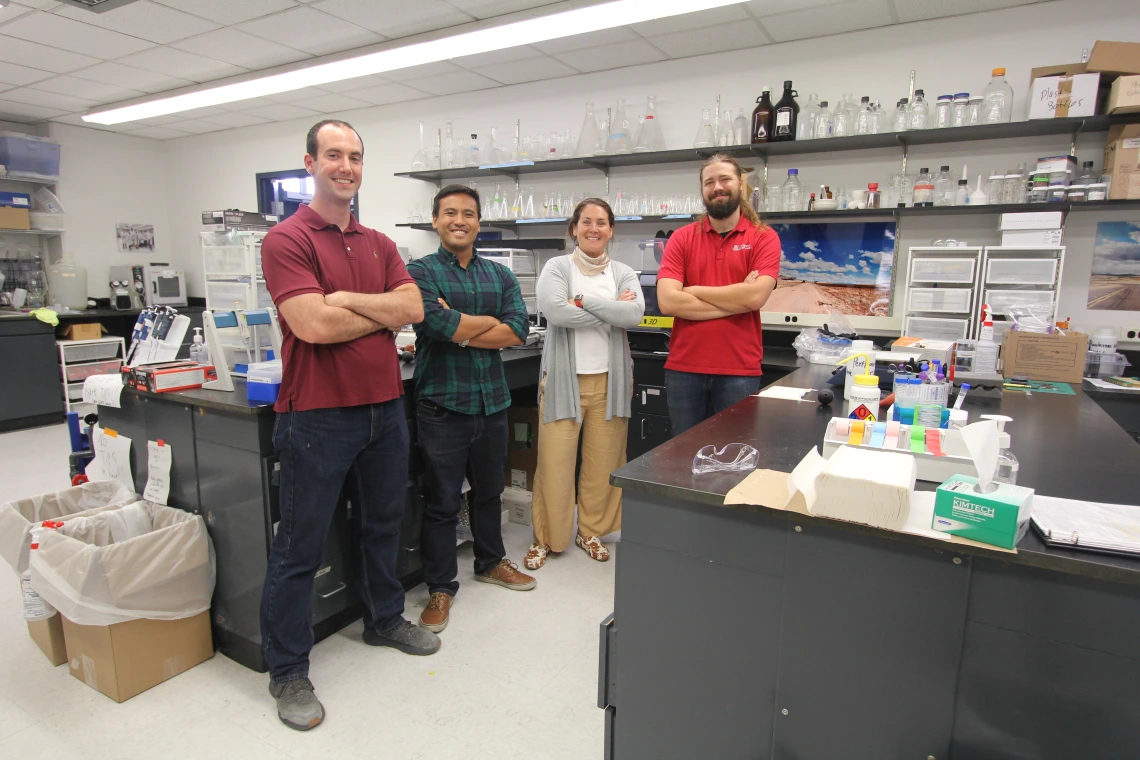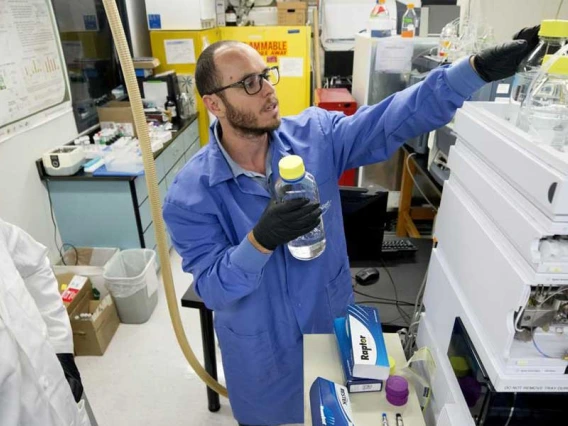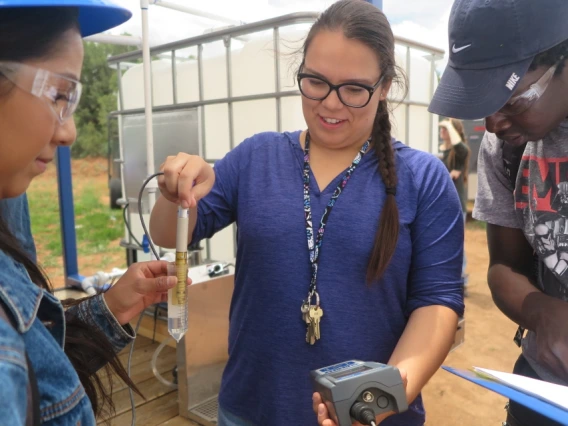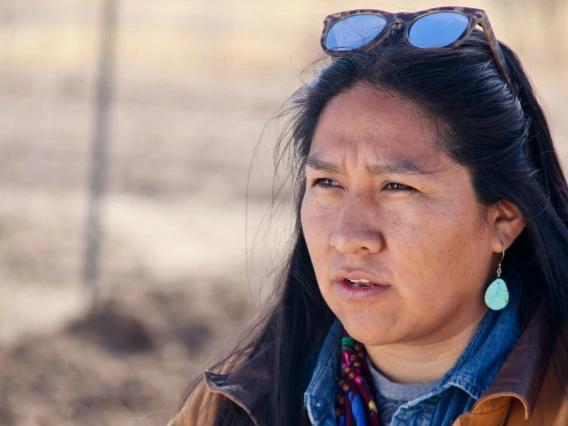$1.4M Effort Develops Reusable Sponges to Soak up Harmful Chemicals From Water
A team of researchers from the University of Arizona and Northern Arizona University is creating a regenerable method for removing stubborn toxins from drinking water – starting with store-bought sponges.

From left to right: Biosystems engineering graduate student Cameron Malloy, chemical and environmental engineering assistant professors Suchol Savagatrup and Vicky Karanikola, and chemical engineering graduate student Jack Welchert.
University of Arizona and Northern Arizona University researchers are developing specialized, reusable sponges to remove a group of chemicals known as PFAS from water. The team, led by chemical and environmental engineering assistant professor Vicky Karanikola, has received $1.487 million from the Arizona Board of Regents, with $1.24 million allocated to UArizona.
PFAS is an abbreviation for perfluoroalkyl and polyfluoroalkyl substances, which are long-lasting manufactured chemicals that are resistant to water, heat and grease. They have been used for decades in products such as makeup, food packaging, nonstick pans, raincoats, carpeting and firefighting foam. But scientists now know exposure to PFAS can be harmful to humans and animals. Health effects include decreased fertility, developmental delays in children and increased risk of some forms of cancer.
The durability of PFAS – the same quality that makes them useful for many applications – means it is very difficult to remove them from the environment, and the chemicals have spread into water sources in areas throughout the world, including Tucson. Removal is an ongoing process. For instance, in a separate effort, the Central Tucson PFAS Project was launched in early 2022 to remove PFAS pollution from groundwater near Davis-Monthan Air Force Base.
"PFAS contamination is a critical issue in Arizona and beyond, and we are so proud that this team, largely made up of early-career faculty members, is leading this effort," said University of Arizona President Robert C. Robbins. "By creating a more sustainable method for PFAS detection and removal, this team aims to make water safer for communities around Arizona."
The first step in this million-dollar effort: Buy off-the-shelf materials from the store.
Making Toxin Cleanup Stick and Unstick
Many sponges are made of cellulose, an abundant organic compound found in plants and used to make materials such as paper and textiles. To draw PFAS out of water, engineers need to use a material that can adsorb PFAS – or, more simply, a material that PFAS will stick to. This part is easy, as PFAS stick to many materials, including cellulose, naturally. The team even has to use polypropylene containers for all of its experiments because PFAS stick to glass.
While simple cellulose sponges are good for initial study of factors such as optimal pore size and density, sponges being developed for removal of PFAS are far more complex. They will soak up PFAS-contaminated water, then squeeze out clean water while the PFAS stay stuck. Then, an extraction solution will remove the PFAS from the sponges so they can be used again.
One common method for removing PFAS from water uses granulated activated carbon, or GAC, another material to which PFAS stick quite well. A little too well, in fact. The tricky part is the unsticking. Getting the PFAS off the GAC so the carbon materials can be reused for another round of removal is expensive and difficult.
"The amount of energy you need to release them from GAC is huge," Karanikola said. "The innovation of this project is that we're focusing on a regenerable method: We want to break that barrier of just using something once and throwing it away. We are trying to find the sweet spot for absorbing it just enough to hold, but that will take the minimum amount of energy to release the PFAS into a controlled environment."
An Economical Approach to a Big Problem
Scientists often isolate and test removal of one contaminant at a time. Outside of the lab, things aren't that simple. There are thousands of PFAS, sometimes called "forever pollutants," and industry is developing more. When the Environmental Protection Agency began regulating two types of long-chain PFAS, which have more than six carbons, industry responded by developing short-chain PFAS. While some speculate that short-chain PFAS may persist in the body for a shorter time, little is known about their effects on health.
To remove a cocktail of PFAS from water, researchers first must detect what types are present. Suchol Savagatrup, project co-investigator and assistant professor of chemical and environmental engineering, is developing electrochemical sensors to selectively detect the presence of many kinds of PFAS.
Like Karanikola's sponge removal process, Savagatrup's sensing method incorporates a thin layer of porous material that attracts very specific molecules. It's like a high-tech version of the game where children match different-shaped pegs to the correct holes.
"Each pore is made essentially by putting molecules of PFAS in there first," Savagatrup explained. "Then, when we remove the molecules, we have a thin layer of holes, and each hole is made specifically for PFAS to come in. It's a selective layer, so if we put it in groundwater that has a bunch of chemical interferences in it, the sensor only picks up the PFAS molecules."
Co-investigator Mark Brusseau, a UArizona professor of environmental science and – according to Karanikola – a "PFAS guru," has spent years developing mathematical models to predict the behaviors of contaminants. He is creating models to guide the development of sensors and sponges that work well in real-world environments. Co-investigator Jani Ingram, a Regents Professor of chemistry and biochemistry at Northern Arizona University, is providing expertise on water quality assessment and public health impacts, particularly with regard to the Navajo Nation.
The team will put its methods to the test with water from three sources in Arizona: Pima County, Coconino County and locations on the Navajo Nation. Tucson is well equipped with resources like sophisticated wastewater reclamation systems and the UArizona Water & Energy Sustainable Technology Center, or WEST Center, which develops technologies related to water sustainability. But the team wants to look at the problem, and its impact on communities, on a larger scale.
"It's a holistic approach that combines economical detection and treatment with modeling to allow for continuous improvement," Karanikola said. "In Arizona overall, and especially Tucson and Pima County, we are really on the forefront of trying to do something meaningful and trying to figure this out."





